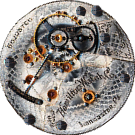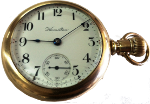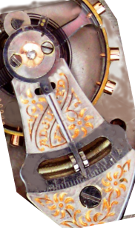When Hamilton opened its doors for business back in 1892, they had a jump on their competition. Railroad companies needed a dependable way to measure time. Though the railroads tried to establish a time system to keep trains on schedule, it failed often.
When a slow train needed to pull over to the side-waiting track and let faster trains pass, this often failed due to bad timing. Schedules called for five to seven minutes for the slow train to move over. Unfortunately poor quality watches failed to keep accurate time and rear end collisions occurred – often only resulting in minor bumps when the slow train sent a flag man out to signal the faster train… It took a few major disasters to push the railroad companies into demanding conductors and engineers use extreme precision watches. Hamilton just happened to get there quickly if not first.
The Great Kipton Train Wreck of 1891, encouraged the Lakeshore and Michigan Railroad to implement a system of inspection. The Official Inspection Report did not indicate that faulty timekeeping was the cause of the wreck. Instead, it blamed the wreck on personnel who failed to follow orders to pull to the side at either the station at Elyria or Norwalk. Both stations were situated prior to Kipton and would have allowed more time for the colliding train to pass.
 |
| Early Hamilton Prototype |
An account of the story appeared in the New York Tribune on 10 January 1910. The journalist attributed the story to Webb C. Ball. You might find some inconsistencies between the Official Report and the Tribune article. You will have to determine what those consistencies mean.
Regardless of the true account of the wreck, a Hamilton Vice President – Webb C. Ball – managed to relay the Lakeshore and Michigan new inspection policies to a reborn watch company in Lancaster, Pennsylvania. Hamilton built the best watch to meet the new standards – especially #5 – Maximum variation of 30 seconds (approximately 4 seconds daily) per weekly check.
Hamilton Vice President, Webb Ball saw an opportunity to provide watch inspections for the Lakeshore and Michigan Railroad company. He began putting together a loose confederation of jewelers to perform inspections for various railroad lines. Prior to Mr. Ball branding the service, jewelers had performed watch inspections for the railroads for decades. Ball convinced a number of jewelers to get more involved in providing the service.
When he started his service, Hamilton benefited. With a network of watch dealers working with the railroads, Mr. Ball began his own watch company out of his jewelry store in Cleveland. Ball’s purchases of Hamilton movements created initial demand for the company’s products.
Ball’s companies never built their own movements; he filled his cases with Hamilton, Elgin and Waltham movements. From 1894 to 1954, Ball purchased 100,000 Hamilton movements. Ball’s first watches contained 936 movements 1894. Those early movements were stamped Ball Standard Superior Grade
Now, ask yourself if Hamilton Watch Company had a head-start in the building watches that met railroad standards. I believe they did. They fit standards purportedly established by Mr. Ball for Lakeshore and Michigan. Though we could find no documentation indicating his role. Perhaps he did. At the time, however, he worked for Hamilton.
Here are the general requirements of the majority of railroad companies’ after the Great Kipton Train Wreck. Further below is an explanation of each requirement.
Railroad Time Standards:
1. Only American-made watches may be used (depending on availability of spare parts)
2. Only open-faced dials, with the stem at 12 o’clock
3. Minimum of 17 functional jewels in the movement
4. 16 or 18-size only
5. Maximum variation of 30 seconds (approximately 4 seconds daily) per weekly check
6. Watch adjusted to at least five positions: Face up and face down (the positions a watch might commonly take when laid on a flat surface); then crown up, crown pointing left, and crown pointing right (the positions a watch might commonly take in a pocket). Occasionally a sixth position, crown pointing down, would be included.
7. Adjusted for severe temperature variance and isochronism (variance in spring tension)
8. Indication of time with bold legible Arabic numerals, outer minute division, second dial, heavy hands, lever used to set the time (no risk of having the stem left out, thus inadvertently setting the watch to an erroneous time)
9. Breguet balance spring
10. Micrometer adjustment regulator
11. Double roller
12. Steel escape wheel
If you would like to understand more about the inner workings of watches, then YouTube has an excellent 19 minute video made by Hamilton entitled How a Watch Works.
#1 American System of Manufacturing (ASM)
From the mid-1800’s to the mid-1900’s, American manufacturing practices allowed the US to dominate world trade, especially in the making of watches. The British or Swiss approach to making watches use individual craftsmen in a cottage trade environment – Master Apprentice to produce watches. Buyers depended on the craftsman that built the watch to repair it and that could take months.
The Master-apprentice system didn’t fit the need of a railroad system with single tracks and side loops for slower trains to pull off and let faster ones pass. It also didn’t work for a country whose railroad system doubled every five years.
US watch manufacturers several million watches under the American Manufacturing System. Supposedly, all US manufacturers used interchangeable parts. As much as we might want to believe that, in the late 1800’s and early 1900’s, only Hamilton produced interchangeable parts. Railroad companies would test for interchangeability by disassembling watches and putting their parts in a tray. While Waltham claimed absolute interchangeability, they didn’t pass. Hamilton did. You could assemble any of the Hamilton parts of the same caliber to make a watch and they ran and ran accurately.
In 1838, Pitkin of Hartford, Connecticut proposed the idea of interchangeability based on the notion of components used in gun manufacturing. American Waltham Watch Co. claimed to have used ASM and by 1891 made 5,000,000 watches using this system. If they were so successful, one has to wonder why Hamilton, founded in 1892, captured 56 percent of the market for railroads within ten years.
In actuality, companies could stamp out parts, but all of them needed finishing. Hamilton did it better than their competition.
Point – Railroad inspectors could determine the reliability and ability to repair watches if produced using ASM.
#2 Open-Face movements have winding stems at the 12 o’clock position. The design makes it easy to see take a watch out of one’s pocket without the chance of hitting the winding stem.
Designers made movements designed to go in a hunting-case (one with a metal lid or cover over the crystal) but if one places it in an open face watch, then the stem winds up at the 3 o’clock position. (That’s referred to as a sidewinder).
 |
| Sidewinder |
The hunting case fell out of favor in the late 1800’s, so watch companies sold the movements at a major discount to clear out their inventory on-hand. Jewelers put the high quality movements in cheap cases for various reasons among including getting a hhigher profit.
#3 I have restored watches made as early as 1903. Two in particular made by Elgin – the 495 and 430 – have 7 jewel configurations. The wheels turn in metal holes rather than jewels. They are nightmares on which to work. The holes actually spread and wear quickly. Broaching is necessary to open the holes, then need the burrs cleaned so the wheel pivots can align with the bridges. Otherwise, the watches are nearly impossible to reassemble. If you don’t broach the hole correctly, you will fail to obtain proper end shake and side shake,or. You can forget about accuracy. Watchmakers have an easy time cleaning, oiling and timing jeweled movements. Reassembly is easy and many 17 jewel watches, have not only lasted over a hundred years, but maintain accuracy.
#4 The larger size pocket watches allow conductors and engineers to see the time at a glance. That’s an obvious need.
#5 Hamilton excelled at maintaining precision timing and that cut down on the number of incidents requiring cleaning and adjusting. The Conductors and Engineers had to buy their watches. Companies didn’t pay for them or even reimburse the buyers. The initial purchase price was expensive, but credit jewelers allowed buyers to pay for their watches in installments. That made it easy to purchase the more expensive Hamiltons.
#6 Watches need to keep accurate time regardless of the position of one’s hand position. For example, the watch may work face up, but slow down with the face down. You don’t want the time to vary from any other position. To facilitate accurate time regardless of the position you hold the watch, a watchmakers can adjust one screw to make a position keep accurate time without having to adjust the other positions. With independent adjustment mechanism an out of balance position such as pendent left will not slow down or speed up he watch.
#7 The vast majority of watches during the late 1800’s and early 1900’s used steel mainsprings and escape coils. Steel expands and retracts based on temperature and can become magnetized. Gold cases, high quality jewels, and different tempered steel gears, allowed watches to maintain accuracy in temperatures between 40 and 100 degrees Fahrenheit. Periodic servicing was required to demagnetize steel components. You had to take it to a watchmaker.
#8 Using Arabic numerals allow for quick glaces. Roman numbers take more time for Americans to read. Placing the second hand in a separate space allows the user to know if 1:01 AM, for example, is about to become 1:02. Count downs and quick glance reading of seconds help the conductors and engineers keep accurate time. If you didn’t know, clearing the track for faster trains went from 7 minutes intervals to 5 minutes and then to 2 minutes as traffic increased faster than new railroad tracks could be laid.
#9 If you don’t know the inner working of watches, I’ll make this as simple as possible. A configuration in a watch mechanism allows it to speed up or slow down. Abraham-Louis Breguet in 1775 discovered how to keep accurate time during the day. Prior to that, watches would speed-up or slow down depending on the time of day. While using Breguet’s method is brilliant, many watch companies did not use deploy it. The reasons vary, but such things as having skilled labor, access to materials, price and so forth kept watch manufacturers stuck with the older methods.
 Railroads needed to maintain accurate time all during the day. 12:00 PM needed to be 12:00 PM, not 11:56 PM at noon and 7:12 PM at 7:09 PM. Breguet balance springs became essential in railroad time systems.
Railroads needed to maintain accurate time all during the day. 12:00 PM needed to be 12:00 PM, not 11:56 PM at noon and 7:12 PM at 7:09 PM. Breguet balance springs became essential in railroad time systems.
#10 If you have ever opened a watch and looked at movement, you may have seen the regulator without knowing it’s purpose. People involved in Horology know exactly what a regulator is and does.
You can adjust the time by moving the long arm to the right or left. To the right, it makes the watch speed up and to the left, the watch slows down. Often you see letters “F” and “S” on the mechanism itself.
Micro-regulators are precise. A small adjustment on a Hamilton can change the time by 15 seconds, whereas other manufacturers watch require an entire turn or a trip to the watchmaker to adjust the time.
# 11 When we discuss the use of a double roller, then we’re talking about an esoteric issue. The roller is part of the balance mechanism. In the image above, look at the round wheel with screws. That’s a balance. It has a jewel that fits in a wheel. The double roller has something called a safety roller that protects the jewel from breaking. It’s an added measure of protection. In 1892, few watch companies used them. Fortunately for Hamilton, they could provide watches with double rollers. That reduced damage from shock.
# 12 Many cheaper watches used brass escape wheels instead of steel. Steel is obvious a harder metal, easier to polish and doesn’t bend.
Perhaps today, we tend to think of these requirements as typical watch features. Back in 1891, few watch companies had put any of these together. Hamilton always came with at least 17 jewels, but Elgin and Waltham did not. The rest of the industry tended to go with six and seven jewel movements. Elgin sold a majority of their watches with 7 and 15 jewel movements. As I intimated above, they are nightmares on which to work.
After releasing its first movement in 1893, Hamilton’s production climbed steadily. Railroad conductors and engineers coveted Hamilton size 16 and 18 open faced watches. In eight short years, Hamilton had captured the railroad market and could not supply demand. Webb C. Ball, turned to other manufacturers to meet his need for product, but still looked to Hamilton.
By 1911, Hamilton had 56% of the railroad market and by expansion of its facilities and work force offered a limited number of watches to men on the street. Eventually, early consumer demand for Hamilton watches allowed them to justify making size 12 movements and small ladies pendent watches as small as 6/0. Consumer watches also had various price points. but the company never sold cheap watches.
Twenty years after the Hamilton Watch Company began offering quality timepieces, the United States Army named the company as the official watch of the military.
Copyright 2006-2017 | All Rights Reserved
